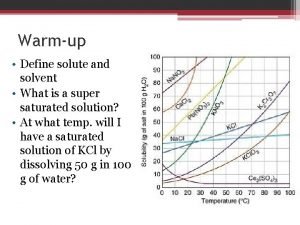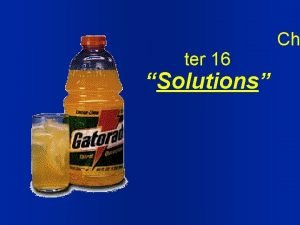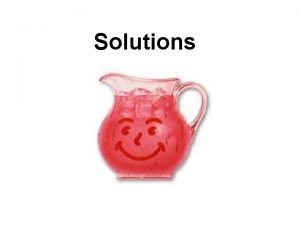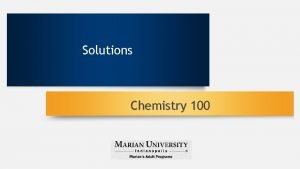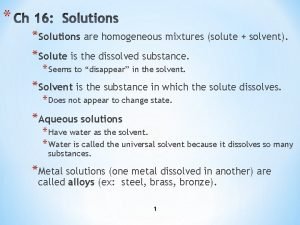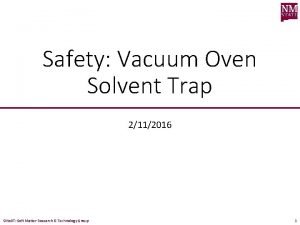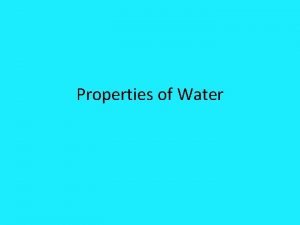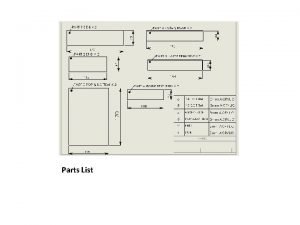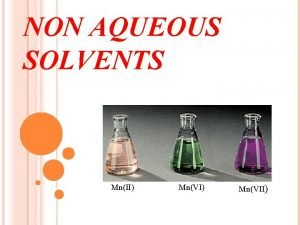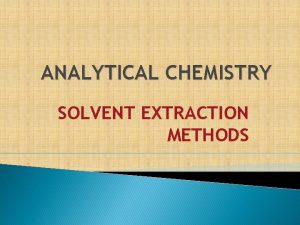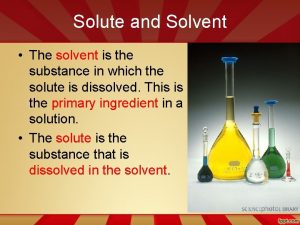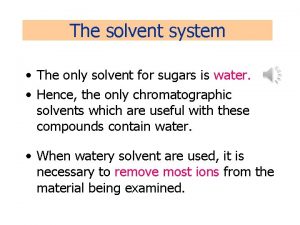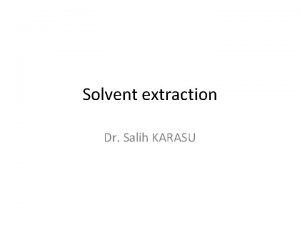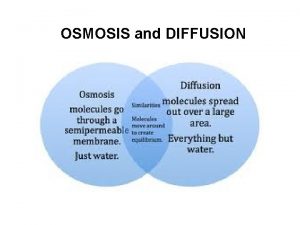Types of Extractors Solvent extractors are of two














- Slides: 14

Types of Extractors Solvent extractors are of two types: Batch Continuous In batch processes, a certain quantity of flakes is contacted with a certain volume of fresh solvent. The miscella is drained off, distilled and the solvent is recirculated through the extractor until the residual oil content in the batch of flakes is reduced to the desired level. In continuous extraction, both the oilseeds and the solvent are fed into the extractor continuously. The different available types are characterized by their geometrical configuration and the method by which solids and solvents are moved one in relation to the other, in counter-current fashion.


Two different methods can be used to bring the solvent to intimate contact with the oilseed material Percolation Immersion

Schlotterhose Extractor


Supercritical Fluid Extraction Supercritical fluids can be used to extract analytes from samples. The main advantages of using supercritical fluids for extractions is that they are inexpensive, extract the analytes faster and more environmentally friendly than organic solvents. For these reasons supercritical fluid CO 2 is the reagent widely used as the supercritical solvent.

Refining Crude oils as received from the extraction plant contain several nontriglyceride components which must be removed. The two min industrial refining methods are chemical/alkali refining and physical refining , with the former using caustic soda to reduce the free fatty acids (neutralisation), while the latter step method does not apply this step and removes the fatty acids during the deodorization step. The crude vegetable oil is then put through further refining techniques including: 1. Degumming 2. Neutralisation 3. Bleaching 4. Deodorisation Sometimes Winterization


Bleaching : The purpose of bleaching (or decolorizing) is mainly to reduce the levels of pigments by using the adsorptive capacity of bleaching clay. The refined oils are usually dark in color due to the presence of some pigmented materials such as chlorophyll or carotenoids and minor impurities like residual phosphatides, soaps, metals and oxidation products. Bleaching reduces the color by absorbing these colorants on bleaching earth (bentonite clays) and/or activated charcoal. Bleaching clay also absorbs suspended matter and other minor impurities.

Natural bleaching clays are aluminum silicates, containing relatively high amounts of Mg, Ca or Fe. The clays are generally activated by heat treatment. The high metal content limits the adsorptive activity of these clays. The metals can be removed from the reactive spots by means of acid treatment, yielding clays with much higher adsorptive capacity. In some cases active carbon is added in the course of bleaching to improve the removal of blue and green pigments as well as polycyclic aromatic hydrocarbons.

Deodorizing: removal of The trace components that cause odors and flavors by the application of heat, steam and vacuum. Most fats and oils, even after refining, have characteristic flavors and odors due to the presence of minor amounts of free fatty acids, aldehydes, ketones and other compounds. The concentration of these undesirable substances, found in most oils, is generally low, between 0. 2 and 0. 5%. The efficient removal of undesirable substances depend on - The vapor pressure of the different minor compounds, - The deodorizing conditions (temperature, pressure, residence time), - The amount of stripping steam - The geometry of the vessel.


Membran Application in Oil refining

 Mikael ferm
Mikael ferm Define solute and solvent
Define solute and solvent Solute vs solvent
Solute vs solvent Ultra shine company manufactures a cleaning solvent
Ultra shine company manufactures a cleaning solvent Solvent vs solute
Solvent vs solute Solute
Solute Solute/solvent
Solute/solvent Quizlet
Quizlet A homogeneous mixture of a solute and solvent
A homogeneous mixture of a solute and solvent Solvent trap for vacuum pump
Solvent trap for vacuum pump Polarity of water
Polarity of water Liquid solvent cement
Liquid solvent cement Classification of non aqueous solvents
Classification of non aqueous solvents C2h6o
C2h6o What is a solution in science grade 7
What is a solution in science grade 7

